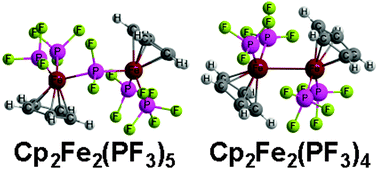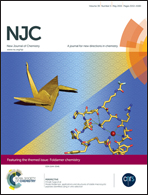Major differences between trifluorophosphine and carbonyl ligands in binuclear cyclopentadienyliron complexes†
Abstract
The cyclopentadienyliron trifluorophosphine hydride CpFe(PF3)2H, in contrast to CpFe(CO)2H, is a stable compound that can be synthesized by reacting Fe(PF3)5 with cyclopentadiene. Theoretical studies on the binuclear Cp2Fe2(PF3)n (n = 5, 4, 3, 2) derivatives derived from CpFe(PF3)2H indicate the absence of viable structures having PF3 ligands bridging Fe–Fe bonds solely through the phosphorus atom. This contrasts with the analogous Cp2Fe2(CO)n systems for which the lowest energy structures have two (for n = 4 and 2) or three (for n = 3) CO groups bridging an iron–iron bond. Higher energy singlet Cp2Fe2(PF3)3 structures have a novel four-electron donor bridging η2-μ-PF3 ligand bonded to one iron atom through its phosphorus atom and to the other iron atom through a fluorine atom. Other higher energy triplet and singlet Cp2Fe2(PF3)2 structures are of the Cp2Fe2F2(μ-PF2)2 type having terminal fluorine atoms and bridging μ-PF2 ligands. The lowest energy Cp2Fe2(PF3)5 structure is actually Cp2Fe2(PF3)3(PF4)(μ-PF2) with a bridging PF2 group and a terminal PF4 group. Such structures are derived from a Cp2Fe2(PF3)4(μ-PF3) precursor by migration of a fluorine atom from the bridging PF3 group to a terminal PF3 group with a low activation energy barrier.


 Please wait while we load your content...
Please wait while we load your content...